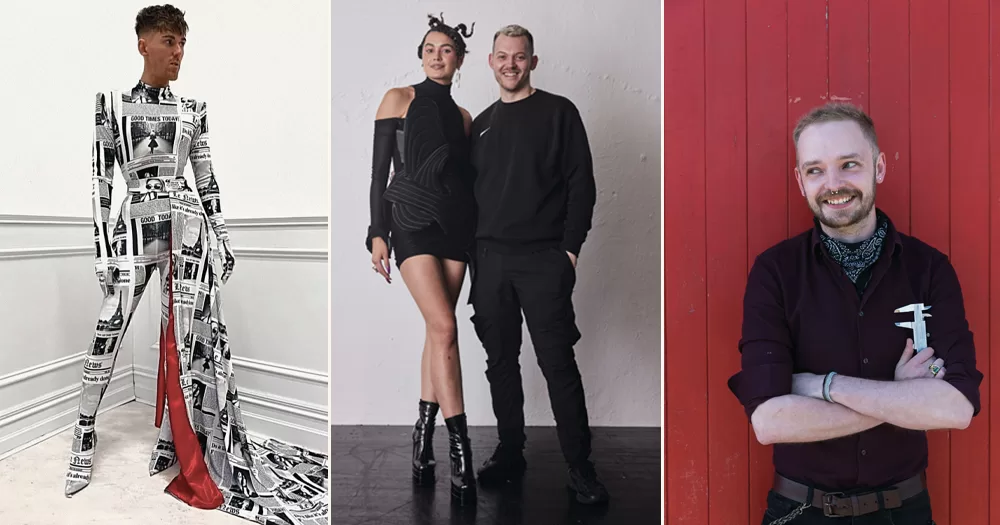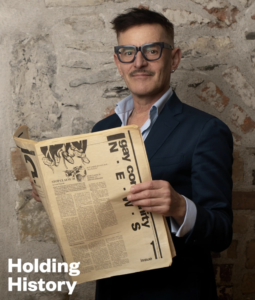Take it from someone who’s known he was gay since birth: clothing is a manifesto. It’s a mission statement, a mood, a public declaration of self and intent. For some, fashion is a means of definition; for others, it’s a small part of a very big, colourful picture. No other time than during Pride month will you see the connection between fashion and queer identity so coherent (and multicoloured). But, as anyone who’s had to come out can tell you, it hasn’t always been that way.
There’s this idea that fashion can act as an armour, a shield that protects us from outside judgment and misinterpretation. And it does. But depending on where you are, it can act as a marker, too; an ‘outing’ tool, so to speak, in areas where flamboyance and full expression of personal style aren’t as accepted or encouraged.
And there were few places less encouraging than Ireland where, particularly in rural areas, brown brogues ruled amongst men with a tucked in shirt and a bootcut jeans pulled so high it would give Simon Cowell a run for his money. I am obviously stereotyping, but it doesn’t mean it isn’t true.
For many young queer creatives, those working in fashion and design, creativity played a big part in their lives growing up.
“I was born with glitter in my veins. I’m a showgirl,” Eamon McGill told me. One of Ireland’s leading designers, Eamon prides himself in the design of show-stopping dresses, having dressed red carpets from the Baftas to the Oscars. “I was forever carrying around a sketchbook, taking inspiration from everyday women to those I saw on Miss Universe.”
https://www.instagram.com/p/COvfFDEpmuf/?hl=it
It’s not all red carpets, none the less gorgeous is Sarah Devereux, the creative behind The Dirt Bird. “I wanted to create art that was both affordable and accessible to my audience, so when I started The Dirt Bird, markets and zine fairs were my focal point rather than exhibitions. My background is visual art, but I never felt like I fitted into, or wanted to for that matter, a gallery space. My work is humorous, it brings a smile to people’s faces which make me giddy like a goose.” Yet, we fly the nest.
Unfortunately for many, once they grow older, they find Ireland limiting in what it can offer and may find themselves moving to mainland UK. But can we only feel safe and live authentically in big UK cities?
“There was a change when I moved to London,” Colin Horgan, a queer fashion designer from Kerry who’s dressed the stars from Dua Lipa to Lady Gaga, told me. “I was introduced to so much- different communities and club nights. It was a sensory overload, but creatively it packed a punch.”
Geographer Gavin Brown, a visiting professor at Dublin’s UCD School of Geography, said that the LGBTQ+ community migrate to larger cities because they are “imagined as being safer and more supportive places, in part because they tend to have more diverse populations and people who are marked as different tend to stand out less”. But conducting research a few years ago on the history of GRAIN (the Gay Rural Aid and Information Network), which existed in the 1970s and early 1980s as a way to support LGBTQ+ people living in rural areas of the UK or wanting to move to the countryside, Brown found that many participants were bored, alienated, or dissatisfied with what gay life in big cities had to offer them. “The history of GRAIN is important for reminding us that LGBTQ+ people have always lived in rural areas and smaller towns and have found ways to make life there more liveable,” Brown clarified.
Horgan continued, “If you look back at my collections you can see there is a hyper energy, a franticness, which is much more articulated and considerate now I’ve moved back home. London inspired me, but it also served as a distraction. There will always be a thread of that which runs through my work, but it is a natural progression.”
There’s a presumption, especially by cis-heterosexual people, that the queer community resides in big cities because we’ve no aspirations other than to splash out on the pink pound and enjoy lives free of responsibilities, but that’s because we see it in people’s shocked expressions when we tell them we dare do something different like become a fashion designer, create bespoke jewellery, or run our own business.
“I remember in school, a teacher actively encouraged me not to take up art,” Mark Newman, a fine jewellery designer told me, “But it just made me more determined to prove him wrong.”
McGill agreed, “We are extra driven to succeed. Nothing like gay shame to make you work harder. Coming from a small town an hour’s drive from the city, where no one studied fashion, it wasn’t a thing. You had to motivate yourself because no one else was going to.”
Luckily for Newman, he also had incredibly supportive art teachers, so much so that he is looking to fulfil that role for someone else. “Three degrees later and with multiple collections and designs behind me, I am keen to share my experience and support future designers coming up through the ranks and be their role model like my teachers were for me”
Jewellery designer Melissa Curry moved to France from Ireland when she was 17. “I was immersed in the LGBTQ+ community in Paris, for me they were my creative family. I was inspired by their energy and exuberance. It was a very liberating time for a young 17-year-old from rural Ireland.”
People outside of society’s dominant groups, such as the LGBTQ+ community, tend to have a different perspective because, since they don’t create the way the world works or follow its societal norms, they are able to criticise society and view it from an outsider’s or objective perspective.
What I personally believe makes queer people so creative is the creation of ourselves – our identity itself is creative. At some point, queer people come to terms with being different, whatever their identity, they realise that they aren’t like most people and perhaps they aren’t who they thought they were themselves.
There are no rules about how to be queer. Yes, there are stereotypes and norms. But one of the beauties of being queer is that we defiantly express our identity however we feel. That’s why you see so many queer people experimenting with fashion. It’s a visible way to explore who we are and who we can be. Some of this is just expressing how we feel deep down, but the process of exploring what we are deep down is a creative process in itself.
Queer people have dominated creative professions for a long time. From Sappho to Bessie Smith to Michelangelo to Gertrude Stein to Margaret Cho to Pedro Almodovar (a random sampling), queer people have revolutionised their medium and reached world fame. In fashion especially, queer designers like Calvin Klein, Marc Jacobs, Gianni Versace… The list is never-ending.
For many queer people, creativity isn’t so much a way of coping as a way of refusing to fit in.
As for the question that haunts the debate of queer people and fashion, Colin had a simple and succinct answer. Why are so many queer people designers? “Because we’re fab,” he said.
Curry continued, “I returned to Dublin in 2004, where I had to reinvent myself. I worked on small projects to keep the creative juices going, and by 2015 I relaunched my career internationally, together with a very expressive rainbow collection which I called OOHLALA. It was very much inspired by the LGBTQ+ community. Ireland was pushing for change which was at the heart and pulse of this collection. The OOHLALA collar was presented to Panti Bliss for Pride 2015.”
All things considered, does Ireland inspire designers? “Yes!” Sarah Devereux responded, “A lot of my designs are based around some of the most relevant moments of Irish history, such as our Nadine (Coyle), certain answering machine voice mails and boss women like Mary Robinson. My work is peppered with recognisable Irish puns and visuals as well as some Celtic knot work and twee Irish fonts printed onto ‘traditional’ Irish homewares like plates, alternative prayers for the kitchen and my version of old Irish blessings.”
© 2023 GCN (Gay Community News). All rights reserved.
This article was published in the print edition Issue No. 376 (March 1, 2023). Click here to read it now.
Support GCN
GCN is a free, vital resource for Ireland’s LGBTQ+ community since 1988.
GCN is a trading name of National LGBT Federation CLG, a registered charity - Charity Number: 20034580.
GCN relies on the generous support of the community and allies to sustain the crucial work that we do. Producing GCN is costly, and, in an industry which has been hugely impacted by rising costs, we need your support to help sustain and grow this vital resource.
Supporting GCN for as little as €1.99 per month will help us continue our work as Ireland’s free, independent LGBTQ+ media.

